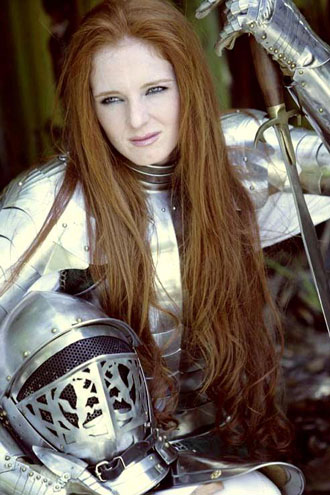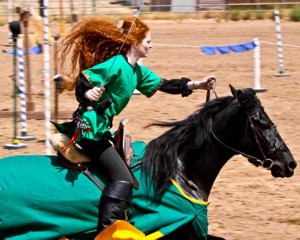Lady Knight Rules the Day
By Nancy Cole Silverman October 1, 2009Most little girls enjoy fairy tales and dressing up like fairy princesses, but for Virginia Hankins carriages and fairy wands could never stack up against powerful, fast-moving horses and knights with lances and shields. “I did have my purple phase,” she admits, but the Simi Valley resident says she was more influenced by Tamora Pierce’s The Song of the Lioness books, about a young redheaded female knight very similar in appearance to Hankins herself.

Virginia Hankins hones her jousting skills by studying dressage and archery. (Photo by Kevyn Major Howard)
To see Hankins dressed as a lady-knight and mounted on Casanova, her nine-year-old black Azteca, her red hair flowing as she charges across a field with her spear held high, is to believe if only for a moment that it’s possible to step back in history and see women like Joan of Arc or Queen Isabella.
Of course, history has few records of lady-knights. Joan of Arc wore armor, but she was never reported to have carried a sword, and though Isabella was known as Spain’s warrior queen, she was never knighted. In the 12th century, there was an order of female knights in Spain: the order of the Hatchet. It was founded by the count of Barcelona after the women of Tortosa mounted up and defended the town against a Moorish attach, but the order appears to have died out with its last member.
A lack of role models hasn’t prevented Hankins from learning as much as she can about what it was to be a knight, and she is determined to be as authentic as possible. She credits her “support crew,” which includes her family and a number of experts, for teaching her tenacity and dedication to the sport. She takes lessons in jousting and mounted archery and also studies dressage with Hilda Gurney in Moorpark.
Hankins relies on another team of professionals to help her look good in the saddle. These include an armorer, a costumer, a custom shield designer, a squire and even a stunt coordinator.
“Michael Gould of Black Diamond Metal Arts took on the task of creating my armor,” Hankins explains. “It’s all 16th century Italian Gothic–style stainless steel and brass.” Her corset is a V-shape design with articulated plates much like those of an armadillo; though it weighs about 35 pounds, it’s fashioned to allow Hankins to move her upper body with ease while riding. She estimates that to date she’s spent in the neighborhood of $7,000 on the costume. “Everything has to be designed for a woman,” she notes, adding that most pieces have to be custom-made for her small frame.

Hankins demonstrates her ability with a sword riding her 9-year-old Azteca gelding Casanova. (Photo by Alan Nimrod)
As a member of the Crimson Rose jousting troupe, Hankins appears regularly at Renaissance faires and private events. She’s also a member of the Society for Creative Anachronism (SCA), an international organization “dedicated to researching and re-creating the arts and skills of pre-17th-century Europe,” and she assists with major events throughout the United States.
The Equestrian News asked Hankins to elaborate on the sport.
The Equestrian News: What kind of horse is best suited to mounted games, combat and jousting?
Victoria Hankins: A horse with a good mind. Any breed can be suitable, but the horse needs to work with you and not “overthink” a situation. Hot-tempered and flighty horses are normally not the best choices. While they can definitely benefit from this kind of training it isn’t normally the best choice.
TEN: Do you need to have a draft horse?
Hankins: No. I’d estimate 60% or more of jousting and games horses in Southern California are what we’d call “light horses”—Arabians, Quarter horses, Tennessee Walking Horses, Andalusians, Mustangs, etc. Some people do use drafts, but they are normally in the heavy armor divisions or looking for a uniform performance look. They aren’t required.
TEN: Do you need to be lifted into the saddle while wearing armor?
Hankins: This is a pretty common myth that actually makes no sense whatsoever. Knights were warriors. If they fell in battle they had to be able to move or they would be killed. I can mount, tack, run, reset equipment or any other number of things while fully suited up.
TEN: What’s the difference between jousting and games?
Hankins: Jousting is a small portion of mounted warfare techniques. The “games” are actually historically based training techniques that have evolved into competitive forms. Popular games include reeds (a sword-based cutting pattern through targets of varying heights), rings (spearing rings between 1” and 6” with a long tapered lance), birjas (tossing a javelin or spear through a wooden hoop and catching it on the other side), tent-pegging (picking up objects from the ground with a lance), javelin (throwing javelins into marked targets), crest combat (opposing riders attempting to strike a target off of the other’s helm with a sword) and quintain (a game for preparing people to joust).
TEN: What makes a good jouster?
Hankins: Tenacity, dedication and patience, lots of patience. This is a hard sport to get into. You have to be willing to keep working towards a goal and stick with it. It doesn’t come overnight. Most jousters do other disciplines. We constantly look for new techniques. Being open-minded and willing to learn gets you far.
TEN: How does someone get involved with jousting or games?

Hankins, a member of the Crimson Rose jousting troupe, performs regularly at Renaissance Fairs and private events. (Photo by Alan Nimrod)
Hankins: The best local resource is the Society for Creative Anachronism, an international nonprofit organization that features a wide range of equestrian events such as mounted combat, games, archery and jousting. They’re hosting a clinic on October 24 from 9 a.m. to 3 p.m. at the Bridle Path Home Owner’s Association in Simi Valley. It’s $20 for riders and free to spectators. Contact equestrian@sca-altavia.org for more information.
TEN: How expensive is it?
Hankins: Medieval games are far cheaper than full jousting. For the games a person can normally get started with their own weapons for under $400. For a full set of jousting armor for theatrical or tournament uses you can easily spend $10,000 or more for just the armor alone before adding in things like horses, lances, shields or the horse’s gear… and then you need to find someone to train with and joust against! Most events are scattered due to the relative rarity of participants, so you have to account for hauling, interstate veterinary paperwork and lodging expenses.
TEN: Do people think you’re crazy for doing this?
Hankins: Some do; most just think it’s interesting. It’s definitely a great way to start a conversation, that’s for sure!
Local SCA practices are held the first and third Fridays of each month from 6:30–8:30 p.m. at the Conejo Creek Equestrian Park in Thousand Oaks, 1350 Avenida de las Flores, Thousand Oaks 91360. Practices are free and open to the public. New members are welcome. Loaner gear and weapons are available, but riders must supply their own horses. Practice participants regularly include off-duty mounted police officers, local horse trainers, people interested in history and experienced riders looking for a unique mounted challenge.
For more information, visit www.sca.org or www.sca-altavia.org .
Short URL: https://theequestriannews.com/?p=2597


